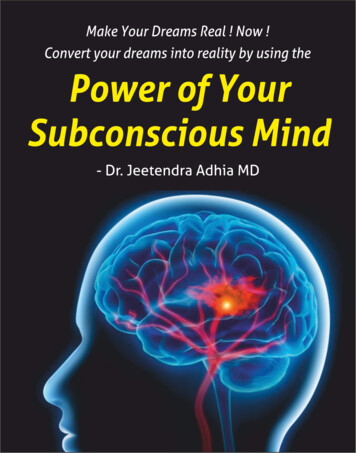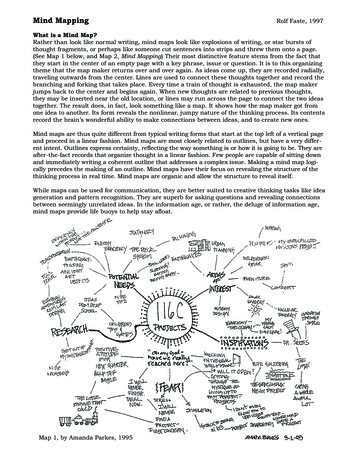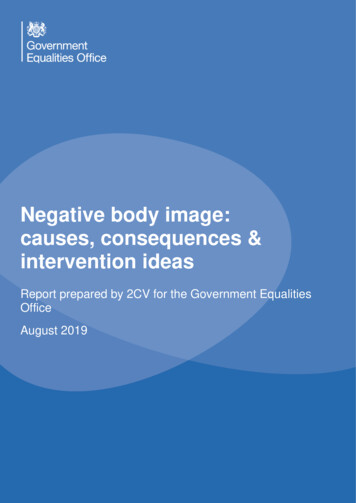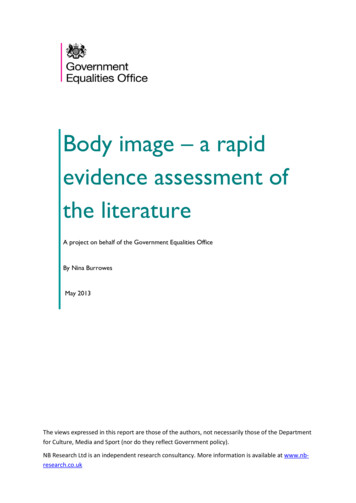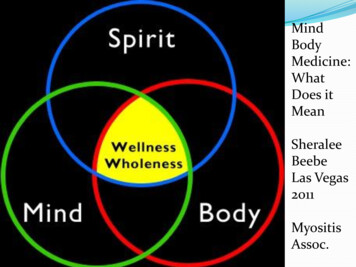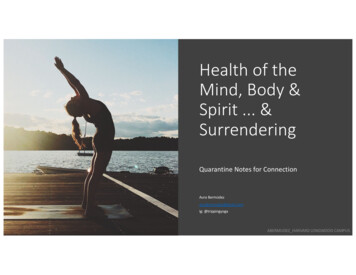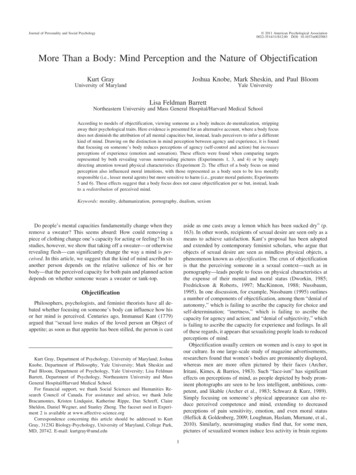
Transcription
Journal of Personality and Social Psychology2011, Vol. , No. , 000 – 000 2011 American Psychological Association0022-3514/11/ 12.00 DOI: 10.1037/a0025883More Than a Body: Mind Perception and the Nature of ObjectificationKurt GrayJoshua Knobe, Mark Sheskin, and Paul BloomUniversity of MarylandYale UniversityLisa Feldman BarrettNortheastern University and Mass General Hospital/Harvard Medical SchoolAccording to models of objectification, viewing someone as a body induces de-mentalization, strippingaway their psychological traits. Here evidence is presented for an alternative account, where a body focusdoes not diminish the attribution of all mental capacities but, instead, leads perceivers to infer a differentkind of mind. Drawing on the distinction in mind perception between agency and experience, it is foundthat focusing on someone’s body reduces perceptions of agency (self-control and action) but increasesperceptions of experience (emotion and sensation). These effects were found when comparing targetsrepresented by both revealing versus nonrevealing pictures (Experiments 1, 3, and 4) or by simplydirecting attention toward physical characteristics (Experiment 2). The effect of a body focus on mindperception also influenced moral intuitions, with those represented as a body seen to be less morallyresponsible (i.e., lesser moral agents) but more sensitive to harm (i.e., greater moral patients; Experiments5 and 6). These effects suggest that a body focus does not cause objectification per se but, instead, leadsto a redistribution of perceived mind.Keywords: morality, dehumanization, pornography, dualism, sexismaside as one casts away a lemon which has been sucked dry” (p.163). In other words, recipients of sexual desire are seen only as ameans to achieve satisfaction. Kant’s proposal has been adoptedand extended by contemporary feminist scholars, who argue thatobjects of sexual desire are seen as mindless physical objects, aphenomenon known as objectification. The crux of objectificationis that the perceiving someone in a sexual context—such as inpornography—leads people to focus on physical characteristics atthe expense of their mental and moral status (Dworkin, 1985;Fredrickson & Roberts, 1997; MacKinnon, 1988; Nussbaum,1995). In one discussion, for example, Nussbaum (1995) outlinesa number of components of objectification, among them “denial ofautonomy,” which is failing to ascribe the capacity for choice andself-determination; “inertness,” which is failing to ascribe thecapacity for agency and action; and “denial of subjectivity,” whichis failing to ascribe the capacity for experience and feelings. In allof these regards, it appears that sexualizing people leads to reducedperceptions of mind.Objectification usually centers on women and is easy to spot inour culture. In one large-scale study of magazine advertisements,researchers found that women’s bodies are prominently displayed,whereas men are more often pictured by their faces (Archer,Iritani, Kimes, & Barrios, 1983). Such “face-ism” has significanteffects on perceptions of mind, as people depicted by body prominent photographs are seen to be less intelligent, ambitious, competent, and likable (Archer et al., 1983; Schwarz & Kurz, 1989).Simply focusing on someone’s physical appearance can also reduce perceived competence and mind, extending to decreasedperceptions of pain sensitivity, emotion, and even moral status(Heflick & Goldenberg, 2009; Loughnan, Haslam, Murnane, et al.,2010). Similarly, neuroimaging studies find that, for some men,pictures of sexualized women induce less activity in brain regionsDo people’s mental capacities fundamentally change when theyremove a sweater? This seems absurd: How could removing apiece of clothing change one’s capacity for acting or feeling? In sixstudies, however, we show that taking off a sweater— or otherwiserevealing flesh— can significantly change the way a mind is perceived. In this article, we suggest that the kind of mind ascribed toanother person depends on the relative salience of his or herbody—that the perceived capacity for both pain and planned actiondepends on whether someone wears a sweater or tank-top.ObjectificationPhilosophers, psychologists, and feminist theorists have all debated whether focusing on someone’s body can influence how hisor her mind is perceived. Centuries ago, Immanuel Kant (1779)argued that “sexual love makes of the loved person an Object ofappetite; as soon as that appetite has been stilled, the person is castKurt Gray, Department of Psychology, University of Maryland; JoshuaKnobe, Department of Philosophy, Yale University; Mark Sheskin andPaul Bloom, Department of Psychology, Yale University; Lisa FeldmanBarrett, Department of Psychology, Northeastern University and MassGeneral Hospital/Harvard Medical School.For financial support, we thank Social Sciences and Humanities Research Council of Canada. For assistance and advice, we thank JulieBracamontes, Kristen Lindquist, Katherine Rippe, Dan Schreff, ClaireSheldon, Daniel Wegner, and Stanley Zheng. The faceset used in Experiment 2 is available at www.affective-science.orgCorrespondence concerning this article should be addressed to KurtGray, 3123G Biology-Psychology, University of Maryland, College Park,MD, 20742. E-mail: kurtgray@umd.edu1
2GRAY, KNOBE, SHESKIN, BLOOM, AND BARRETTassociated with mental-state attribution (Cikara, Eberhardt, &Fiske, 2010). Such sexualizing can also impact women’s behavior,as those who receive a body-focused “objectifying gaze”—a longlook up and down from a man—performed worse at a math exam(Gervais, Vescio, & Allen, 2011).Although the bulk of research on objectification is linked tosexualizing, it is also possible to de-mentalize others without thepresence of sexual desire. In fact, research finds that those whoevoke the opposite response of sexual attraction— disgust—arealso de-mentalized (Harris & Fiske, 2006). One can also objectify oneself (Fredrickson & Roberts, 1997; Fredrickson, Roberts, Noll, Quinn, & Twenge, 1998), and for women, suchself-objectification is linked with disordered eating, cognitivedistraction (Fredrickson et al., 1998), depression (Szymanski &Henning, 2007; Tiggemann & Kuring, 2004), and even selfharm (Muehlenkamp, Swanson, & Brausch, 2005). The lessonabout objectification seems clear: Thinking of someone as abody reduces ascriptions of mind.Two Dimensions of MindThe research and theorizing so far on the nature of objectification presupposes that mind perception can be understood in termsof a single underlying continuum, where an entity falls somewherebetween no mind (like an inanimate object) and full mind (like anormal human being; but see Loughnan, Haslam, Murnane, et al.,2010; Nussbaum, 1995). According to this model, objectifying aperson means shifting that person a few notches down the continuum, away from full-fledged personhood and toward inanimacy asa mere object—less agency, less autonomy, less capacity forsubjective experience, and so on.Recent research indicates, however, that minds are perceivedalong two dimensions, not one. In one study, participants wereasked to evaluate the various mental capacities of a number ofdifferent entities, including people, animals, and supernaturalagents (H. M. Gray, Gray, & Wegner, 2007). These mental capacities were submitted to a factor analysis that revealed two dimensions of mind perception: agency and experience. Agency is thecapacity to act, plan and exert self-control, whereas Experience isthe capacity to feel pain, pleasure and emotions. These two dimensions of mind perception parallel the twofold structure of otherconcepts in social cognition, most notably humanness (UniquelyHuman and Human Nature; Haslam, 2006; Haslam, Loughnan,Kashima, & Bain, 2008), the content of stereotypes (Competenceand Warmth; Fiske, Cuddy, & Glick, 2007; Judd, James-Hawkins,Yzerbyt, & Kashima, 2005), and personality (Dominance andNurturance; Wiggins & Broughton, 1991).This two-dimensional structure of mind perception suggests thatpast work on objectification is incomplete, as this research hasfocused almost exclusively on Agency-related traits, such as competence, intelligence, and ambition (e.g., Archer et al., 1983; butsee Loughnan, Haslam, Murnane, et al., 2010). Here, we examinethe effect of focusing on the body for the ascription of both agencyand experience. Consistent with previous research, we expect thata body focus will reduce perceptions of agency, but importantly,we suggest that a body focus will increase perceptions of experience. Although, at first glance, this prediction appears to contradictmuch theorizing on objectification, there is ample evidence for alink between experience and the body.Experience and the BodyWhen people feel emotions, their bodies are intimately involved. Hands tremble with fear, stomachs churn with love, andfists clench with rage. Experimental evidence confirms that emotions are embodied, routinely relying on interoceptive feelingsfrom the core of the body for their experience (Barrett & Lindquist,2008; Niedenthal, Barsalou, Winkielman, Krauth-Gruber, & Ric,2005). Indeed, simply smiling can make jokes funnier (Strack,Martin, & Stepper, 1988), and temporarily paralyzing faces withBotox can reduce the experience of emotion (Davis, Senghas,Brandt, & Ochsner, 2010).This link between the body and emotion exists not only forfeeling emotions but also for emotion perception, whereby peopleseem willing to ascribe the capacity for experience only to entitieswith flesh. For example, people may be willing to ascribe entitiessuch as computers and robots mental capacities such as “belief” or“knowledge,” but without flesh, people are reluctant to ascribethem capacities for happiness or pain (H. M. Gray et al., 2007;Huebner, 2010). People are similarly unwilling to ascribe experience to a disembodied God (K. Gray & Wegner, 2010a) or tocorporations, which despite being composed of many people, lacka bodies themselves (Arico, 2010; Huebner, Bruno, & Sarkissian,2010; Knobe & Prinz, 2008). The most likely reason for thisperceived link between bodies and experience is that most of ourexperiences are mediated by physical organs, whether skin (e.g.,pain/pleasure), nose (e.g., digust), eyes (e.g., conscious vision), orthe loins (e.g., desire).As biological bodies are linked to perceptions of experience(Knobe, 2008), it may be that simply focusing on someone’s bodyor flesh causes people to see that person more in terms of experience. But why would focusing on a body both increase perceptions of experience and decrease perceptions of agency? Commonsense dualism suggests an explanation. This is the notion thatpeople intuitively think of minds and bodies as distinct, or evenopposite (Bloom, 2004; Demertzi et al., 2009; K. Gray, Knickman,& Wegner, 2011). If these two perspectives are in opposition, thenit suggests that the more you focus on someone’s body, the lessyou perceive them to have any mind at all. At first, such dualismseems to support the standard objectification claim—mind versusmindless body— however, the link between body and experiencesuggests that the conflict might instead be between an agenticmind versus an experiential body.In other words, rather than a conflict between a physical objectand an immaterial soul, dualism may be a conflict between rationalagency (“mind”) and the seething passions of experience (“body”).People may thus have a tendency to view someone as capable ofeither agency or experience, either as someone capable of thinkingor as someone capable of feeling. So although the dimensions ofagency and experience are normally orthogonal, these dimensionsmay become inversely related when conceiving someone as a“mind” or as a body. Such an opposing relation between agencyand experience has been uncovered in various other domains,including the moral domain (moral typecasting; K. Gray &Wegner, 2009, 2010b, 2011b) and the stereotyping literature(Fiske et al., 2007; Judd et al., 2005; Kervyn, Yzerbyt, Judd, &Nunes, 2009). In these studies, there is often an explicit or implicitcomparison between another social group (e.g., Judd et al., 2005)or another moral entity (e.g., K. Gray & Wegner, 2009) that helps
MIND PERCEPTION AND OBJECTIFICATIONto induce this compensatory relation. We suggest that dualism setsup an intuitive comparison—and opposition— between the agenticmind and experiencing body.The idea that a body focus can lead to both decreased andincreased mind stands in contrast to the term “objectification,”because it suggests that people seen as bodies are not seen asmindless objects but, instead, as experiencers: someone morecapable of pain, pleasure, desire, sensation, and emotion but lacking in agency. In other words, focusing on the body does not leadto de-mentalization but to a redistribution of mind.If a body focus leads to a redistribution of mind—in which thetotal amount of perceived mind remains the same despite beingreallocated between the two dimensions—it would not only overturn traditional notions of objectification but would also haveimplications for the moral domain. Ascriptions of moral responsibility are linked to perceptions of agency (H. M. Gray et al.,2007), so a body focus should decrease perceptions of moralresponsibility. Alternatively, ascriptions of moral rights are linkedto perceptions of experience (H. M. Gray et al., 2007; Regan,1985), so if a body focus increases perceived experience, it shouldalso lead to a greater perceived entitlement to avoid harm. Forexample, one study found that the more an entity was perceived ascapable of feeling pain, pleasure, fear, and desire, the more itdeserved to be protected from harm (H. M. Gray et al., 2007).Thus, if seeing someone as a body increases ascriptions of experience, it should also increase the conferral moral rights, not stripthem away. Objectification, then, may not be objectification at all.Seeing someone as a body may simply lead to ascriptions of adifferent kind of mind, with different moral status.pants made ratings of agency and experience for targets— both a manand a women— depicted either as a face or as a face plus upper body.In line with previous research that used a similar methodology (e.g.,Archer et al., 1983; Loughnan, Haslam, Murnane, et al., 2010), it waspredicted that the target showing more body would be evaluated ashaving decreased agency (the capacity for self-control, planning, andacting morally). Importantly, it was also predicted that targets showing increased body would be seen to possess more experience (thecapacity to feel pleasure, hunger, and desire).MethodParticipants. One hundred fifty-nine participants (82 female,M age 23 years) were recruited in on-campus dining halls andcompensated with the gratitude of the experimenter.Procedure and materials. Participants were given a questionnaire with a picture and a brief description of one of two targets: onefemale, one male. The female target’s description read:This is Erin. She attends a liberal arts college in New England andmajors in English. Outside of class, she is a member of a few studentgroups. On weekends, Erin likes to hang out with friends.The male target’s description was identical, expect the name waschanged to Aaron, and “she” was replaced with “he.” Above thesedescriptions were pictures of Erin/Aaron. In the face condition,this picture was of their faces, whereas in the body condition, thispicture also included their upper body (see Figure 1).The Present ResearchIn five experiments, we tested the redistribution of mind hypothesis, that men and women represented by their bodies seemless capable of agency (self-control and planning) but more capable of experience (sensitive to pain and emotion). Experiment 1explored whether redistribution occurred when viewing picturesdepicting targets by just their face or by their face and body.Experiment 2 investigated whether redistribution could be obtained with a manipulation of attention toward either the “mind” orthe “body.” Experiment 3 tested whether redistribution of mindoccurred with a more diverse participant pool and a larger set oftargets. Experiment 4 investigated the role of sexually suggestiveness and attractiveness in attributions of mind, with the predictionthat sexual suggestiveness should be linked to redistribution ofmind. The final two studies examined the moral implications of theredistribution hypothesis. Experiment 5 tested whether focusing onthe body increases relative perceptions of moral patiency, a person’s perceived capacity to be harmed at the hands of another,while also decreasing relative moral agency, a person’s perceivedcapacity to earn blame. Experiment 6 tested whether focusing onanother’s body leads to increased moral status, whereby the exposure of skin causes people to protect others from the harm ofelectric shocks.Experiment 1: Bodies Versus FacesThis experiment investigated whether ascriptions of agency andexperience depended on the relative salience of the body. Partici-3Figure 1. Pictures used in Experiment 1.
4GRAY, KNOBE, SHESKIN, BLOOM, AND BARRETTAfter reading the brief description, participants were tasked withevaluating the mental capacities of the target. Specifically, participants answered six questions, which took the form, “Compared tothe average person, how much is Erin capable of X.” Substitutingfor the “X” were the agency-related capacities of “self-control,”“acting morally,” and “planning” and the experience-related capacities of “experiencing pleasure,” “experiencing hunger,” and“experiencing desire.” These capacities were chosen because theyrepresent capacities that load highly on their respective dimensionsin H. M. Gray et al. (2007). Participants answered these sixquestions on a 5-point scale from 1 (Much Less Capable) to 5(Much More Capable), with 3 (Equally as Capable) as the midpoint.Indices of mind perception. Before analyzing perceptions ofagency and experience, indices were constructed. The data fromthe six mind ratings questions were submitted to a factor analysis,which yielded two orthogonal factors with eigenvalues 1. Thefirst factor corresponded to agency and included self-control (rotated factor loading .66), acting morally, (.49) and planning(.79). The second factor corresponded to experience and includedpleasure (.38), hunger (.74), and desire (.59). Thus, the agencycapacities were averaged to form an agency index, and the experience capacities were averaged to form an experience index. Theagency index had an alpha of .53, which is not high; however,previous research has validated the use of such a scale (K. Gray &Wegner, 2009), most recently with a confirmatory factor analysis(K. Gray, Jenkins, Heberlein, & Wegner, 2011). Reassuringly, allagency variables were significantly intercorrelated, mean r(157) .28, p .001. The experience index, however, had a much loweralpha of .21. When the intercorrelations were examined, it wasfound that hunger had a negligible correlation with the other twovariables (rs .1), possibly because the pictures used thin models.As desire and pleasure were significantly correlated r(157) .23,p .001, it was these two variables that composed the experienceindex.Results and DiscussionThe agency and experience indices were submitted to a 2(Capacity: agency, experience) 2 (Condition: face, body) 2(Target: Aaron, Erin) 2 (Participant: male, female) withinbetween-subjects analysis of variance (ANOVA). The analysisrevealed two significant two-way interactions: one as predictedbetween capacity (agency, experience) and condition (face, body),F(1, 142) 18.24, 2 .11, and one between capacity (agency,experience) and target (Aaron, Erin), F(1, 142) 8.90, 2 .06.There were no significant sex differences or higher order interactions.Our interaction of interest was between capacity (agency, experience) and condition (face, body). Exploration of this interactionwith simple effects confidence intervals found that targets depictedby their body were seen, as predicted, to have more experience(M 3.65, SD 0.69) than face depicted targets (M 3.38, SD 0.69), p .01. Body depicted targets were also seen, as predicted, tohave less agency (M 2.90, SD 0.49) than those depicted by theirface (M 3.23, SD 0.64), p .01 (see Figure 2). These resultssupport the hypothesis that focusing on the body does not involvecomplete de-mentalization but instead redistribution of mind, withdecreased agency but increased experience.Figure 2. Perceptions of agency and experience for targets depicted byeither their faces (Face) or faces and upper bodies (Body; Experiment 1).Error bars are 1 SE.Exploring the capacity by target interaction with simple effectsconfidence intervals found that Erin was seen to have more agency(M 3.21, SD 0.52) than Aaron (M 2.91, SD 0.63, p .05), and Erin was seen as having somewhat less experience (M 3.45, SD 0.52) than Aaron (M 3.59, SD 0.76), although notsignificantly so (p .20).The results of this study provide evidence for the redistributionof mind hypothesis; the next study attempts to replicate thisfinding using a different method. Whereas this study used differentpictures to manipulate the salience of the body, the next study usedthe same pictures in each condition but manipulated perceiverattention by asking people to focus on either physical or mentalcharacteristics of another person (such as in Heflick & Goldenberg, 2009). It was predicted that simply focusing on physical,rather than mental, characteristics would be enough to reduceperceptions of agency and increased those of experience.Experiment 2: Smartness or Sexiness?Imagine evaluating pictures of people while you have one oftwo different mindsets. In the first mindset, you are on an onlinedating website, perusing pictures and looking to find someoneattractive enough to date. In the second mindset, you are lookingat pictures of potential job candidates, seeking someoneprofessional-looking to hire. Although each of these evaluationsuse a picture as the basis, the first looks explicitly at physicalcharacteristics, whereas the second uses these characteristics as anindicator of mental capacities. In other words, evaluating forattractiveness has an increased focus on the body, and evaluatingfor professionalism has a decreased focus on the body. As the bodyis predicted to be linked to decreased agency and increased experience, focusing attention on physical, bodily characteristicsshould cause the redistribution of mind found in the previousexperiment.In this experiment, participants evaluated a series of picturedtargets on either professionalism or attractiveness, and then compared targets on mind perception. It was predicted that thosetargets evaluated for attractiveness would be seen as relativelymore capable of experience and less capable of agency than thosetargets evaluated for professionalism. This would provide addi-
MIND PERCEPTION AND OBJECTIFICATIONtional evidence that focusing on the body does not lead to dementalization but, instead, to redistribution of mind.MethodParticipants. Twenty-eight participants (18 female, M age 26years) were recruited via SONA, an online study pool recruitment platform. Participants were compensated for the half-hourstudy with 5 or study credit.Procedure and materials. Participants were presented withpictures of faces of young women and asked to make evaluationsof the women they pictured. Eighteen pictures were taken from apreviously used facial set (Barrett & Bliss-Moreau, 2009) anddivided into nine pairs, such that women within a pair weremaximally similarly on attractiveness (a previous pilot test ratedwomen on attractiveness). For each pair of women, participantsevaluated one on professionalism by answering four questions,presented in a random order—“How knowledgeable is thiswoman?” “How efficient is this woman?” “How capable is thiswoman?” “How smart is this woman?”— on a 5-point scale from1 (Not at All) to 5 (Extremely). Participants evaluated the otherwoman in the pair on attractiveness by answering the four questions—“How attractive is this woman?” “How sexy is thiswoman?” “How pretty is this woman?” “How cute is this woman?”— on the same 5-point scale.This evaluation task served as our mind- or body-focused manipulation. After making those eight evaluations, participantsmade an additional six evaluations for each pair that examinedrelative perceptions of agency and experience. The questionsasked, “Between Woman A and Woman B, who is more capableof X?” Capacities assessed were self-control, acting morally, andplanning (for agency) and experiencing pleasure, experiencingdesire, and experiencing fear (for experience; fear replaced hungerbecause of its poor intercorrelation in Study 1). Participants an-5swered this question on a 6-point scale from –2.5 (DefinitelyWoman A) to 2.5 (Definitely Woman B), with a hypotheticalmidpoint of equality/indifference at zero.It was predicted that the woman in the pair who was initiallyevaluated in terms of attractiveness would be seen to have relatively less agency and more experience than the woman who wasinitially evaluated in terms of professionalism. To ensure thiseffect was not due to some preexisting difference between pictures,there were two different orders between subjects. In Order 1, onewoman in the pair was evaluated on professionalism and the otheron attractiveness; in Order 2, the evaluations were switched. It waspredicted that, across pairs, the same pairs of women would beseen differently in terms of agency and experience, depending onthe order/mindset induced.Indices of mind perception. To test the cohesiveness ofagency and experience across targets, individual capacities werefirst averaged across pairs of women. Self-control, acting morally,and planning were then combined into an agency index ( .55),and feeling pleasure, fear, and desire were combined into anexperience index ( .53). Note that this alpha is much higherthan in the previous study.Results and DiscussionIndices of agency and experience provided relative judgmentswithin picture pairs of perceptions of mind and were submitted toa 2 (Capacity: agency, experience) 2 (Order: one, two) 2(Participant: male, female) mixed within-between-subjectsANOVA. Only one significant interaction was revealed: the predicted interaction between mental capacity and order, F(1, 24) 16.47, 2 .41, suggesting that the relative evaluations of themental capacities of agency and experience depended on whichmindset participants used to evaluate each woman within a pair(see Figure 3). Simple effects confidence intervals revealed thatFigure 3. Relative perceptions of agency and experience of women within a pair, depending on initial mindset(Experiment 2). Error bars are 1 SE.
6GRAY, KNOBE, SHESKIN, BLOOM, AND BARRETTwhen Woman B was evaluated for attractiveness, she was seen tohave relatively less agency (M –.11, SD .17) than when shewas evaluated for professionalism (M .13, SD .26), F(1,24) 8.19, p .01. When Woman B was evaluated for attractiveness, she was also seen to have relatively more experience(M .07, SD .19) than when she was evaluated for professionalism (M –.19, SD .19), F(1, 24) 11.02, p .01 (see Figure3). Because these were relative judgments, the findings for WomanA are the same, only reversed.These data provide support for the redistribution of mind and thegeneral conflict between conceiving of people as both rationalminds and bodies with seething passions. Evaluating people witha “physical” body-focused mindset makes them seem relativelyless agentic and more experiential. On the other hand, evaluatingother with a mindset less focused on the body makes them seemrelatively more agentic and less experiential. In the next study, weexamine a broader sample of targets to test the robustness of thesefindings.Experiment 3: A Feast of FleshThrough two experiments, we have found that focusing on abody leads to a redistribution of mind: decreased ascriptions ofagency and increased perceptions of experience. Each of theseprevious two studies has limitations, however. Experiment 1 usedonly one female and one male target to assess mind perception,whereas Experiment 2 used comparative measures of mind. Furthermore, both these experiments used reasonably truncated scalesto assess mind perception. In this experiment, we use a morecomprehensive design to examine whether the salience of fleshserves to redistribute mind. Specifically, participants were pre-sented with one of 10 targets, pictured either naked or clothed, andare asked to rate 12 mental capacities (six agency-related, sixexperience-related). These pairs of pictures were taken by a professional photographer and are tightly controlled for posture, expression, and lighting— only the presence of clothing varies between them. We predicted that, relative to the clothed targets, thenaked targets would be ascribed less agency but more experience.MethodParticipants. Five hundred sixty-five participants (47% female, M age 31 years) were recruited from a variety of countries(including the United States, France, Saudi Arabia, the Philippines,and Pakistan) through Amazon’s Mechanical Turk (MTurk),which has been shown to provide high quality data from a relatively diverse sample (Buhrmester, Kwang, & Gosling, 2011).Thirty-eight participants were excluded for failing the manipulation check—they incorrectly answered whether the person theysaw was clothed or naked and male or female. This was done toeliminate people who blindly clicked through the survey for payment.Procedure and materials. Participants received 10 for theirparticipation in a 4-min survey entitled “Rating People in Pictures.” Upon coming to the survey, participants were presentedwith one of 20 pictures taken from a book that presents standardclothed portraits of adult film stars, each of which is matched withan iden
a body focus will reduce perceptions of agency, but importantly, we suggest that a body focus will increase perceptions of experi-ence. Although, at first glance, this prediction appears to contradict much theorizing on objectification, there is ample evidence for a link between experience and th
